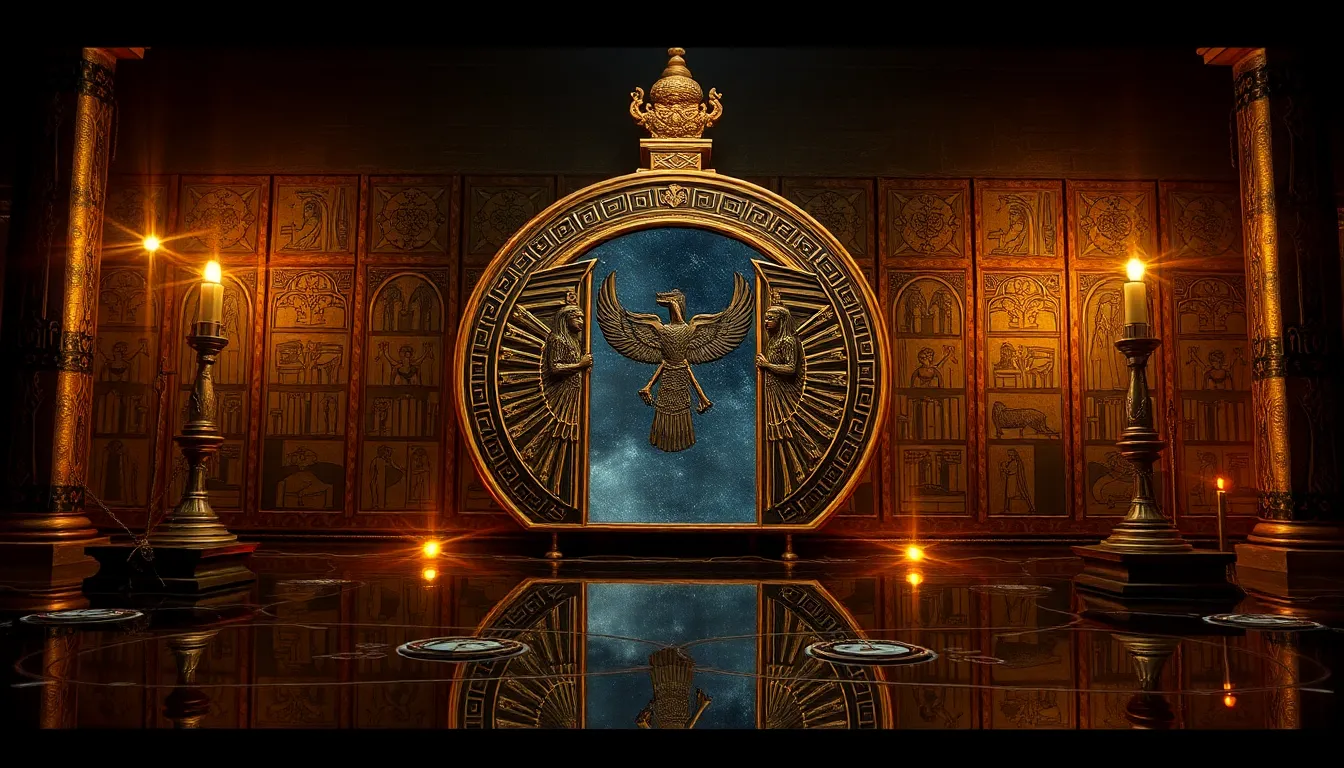The Tale of the Sacred Mirror: Reflection and Truth in Egyptian Beliefs
I. Introduction
Egyptian mythology is a rich tapestry of beliefs and stories that have captivated the imagination for millennia. Central to this mythology are the concepts of truth, beauty, and the afterlife, each woven intricately into the fabric of ancient Egyptian culture. Among the various artifacts that held significance, mirrors occupied a unique place, serving as both objects of luxury and deep symbols of self-awareness and truth.
This article explores the multifaceted role of mirrors in ancient Egypt, delving into their symbolism, spiritual implications, and the myths surrounding them. Through this exploration, we aim to illuminate how these reflections connected the ancient Egyptians to their beliefs about life, death, and the divine.
II. The Symbolism of Mirrors in Ancient Egypt
Mirrors in ancient Egypt were more than just reflective surfaces; they were imbued with deep symbolism and meaning.
- Mirrors as objects of beauty and luxury: Crafted from polished metals such as bronze and copper, or made with glass, mirrors were prized possessions often owned by the elite. They represented not only physical beauty but also the wealth and status of their owners.
- Mirrors as symbols of truth and self-awareness: In a culture that revered the concept of truth, mirrors served as a tool for self-examination. They encouraged individuals to confront their own reflections, both literally and metaphorically.
- The connection between mirrors and the afterlife: Mirrors were believed to have protective qualities, especially in funerary contexts, reflecting the soul’s true essence and aiding in its journey to the afterlife.
III. The Role of Reflection in Egyptian Spirituality
The act of reflection transcended the physical properties of mirrors, becoming a metaphor for spiritual introspection.
- Reflection as a metaphor for inner truth: Just as a mirror reflects the external image, it was believed that self-reflection could reveal deeper truths about one’s character and actions.
- The concept of Ma’at: Central to Egyptian belief was the goddess Ma’at, embodying truth, balance, and order. Mirrors symbolized the need for harmony between one’s actions and the cosmic order.
- How reflection relates to the judgment of the soul: In the afterlife, the heart of the deceased was weighed against the feather of Ma’at. This judgment required the soul to reflect on its life and actions, reinforcing the idea that truth and self-awareness were paramount.
IV. The Sacred Mirror: Myths and Legends
Egyptian mythology is rich with tales that incorporate mirrors as sacred objects.
- Tales of divine mirrors: Many myths highlight mirrors as gifts from the gods, often possessing magical properties that could reveal hidden truths or grant insights into the future.
- The association with deities: Mirrors were often linked to goddesses such as Hathor, who represented beauty and love, and Isis, who embodied wisdom and protection.
- Notable myths involving mirrors: In various stories, mirrors are depicted as instruments through which heroes and mortals could glimpse the divine, leading to moral lessons about vanity and the pursuit of truth.
V. Mirrors in Funerary Practices
Mirrors played a significant role in ancient Egyptian funerary practices, believed to possess protective and reflective qualities.
- The use of mirrors in burial rituals: Mirrors were often placed in tombs as offerings, intended to reflect the deceased’s soul and guide it safely to the afterlife.
- Mirrors as tools for protection: It was believed that mirrors could ward off malevolent spirits, ensuring that the soul could navigate the afterlife without obstruction.
- The cultural significance of mirrors in tomb art: Artistic representations of mirrors in tombs often symbolized the journey of the soul and its quest for eternal truth.
VI. Artistic Representations of Mirrors in Egyptian Art
Mirrors were not just functional objects; they were also celebrated in art and craftsmanship.
- Depictions of mirrors in paintings and carvings: Ancient artists frequently included mirrors in their works, symbolizing beauty and reflection in both life and the afterlife.
- The craftsmanship of ancient Egyptian mirrors: The creation of mirrors required skilled artisans, and the intricate designs often featured motifs that conveyed themes of protection and beauty.
- Analysis of mirror motifs: Mirrors found in tombs and temples often carried significant motifs that related to the gods and the ideals of truth and beauty, enhancing their spiritual importance.
VII. Modern Interpretations of the Sacred Mirror
Today, the symbolic nature of mirrors in ancient Egyptian culture continues to resonate.
- Contemporary relevance: Modern spirituality often emphasizes self-reflection, truth, and authenticity, echoing the lessons from ancient Egyptian beliefs.
- How the concept of reflection resonates today: Mirrors serve as a reminder of the importance of self-awareness in personal growth and moral integrity.
- The influence of ancient Egyptian culture: The motifs and symbols associated with mirrors have inspired countless works of art, literature, and spiritual practices in contemporary society.
VIII. Conclusion
In conclusion, mirrors held a place of profound significance in ancient Egyptian beliefs, symbolizing beauty, truth, and the journey of the soul. They served as powerful tools for self-reflection and were woven into the fabric of spiritual practices and funerary rites. The enduring legacy of the sacred mirror continues to invite exploration of ancient Egyptian spirituality and its relevance in understanding our own quest for truth.
As we reflect on these ancient beliefs, we are reminded of the timeless nature of seeking truth and the importance of understanding ourselves in a world full of reflections.




